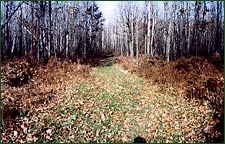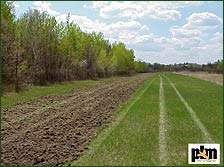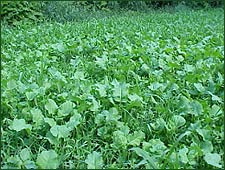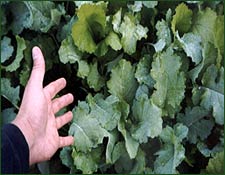|
Location...location...location. You may experience
low use of food plots if located in an area of low whitetail
use or an area of poor cover. Even worse, if you attract
deer to an unprotected area from predators and/or winter
weather, you may be doing more harm than good.
Working with good soils will allow you to provide better
seedbed preparation and to realize better growth in
your food plots. If you are working in really wet soils
or really dry soils, it is important that you understand
the limitations of these soils. Try to chose better
soil conditions if you are fortunate enough to have
them on your property.
Tree and brush removal is labor intensive and can be
expensive. Try to locate food plots in areas where brush
removal is a minimum with reduced preparation needs...however,
do not compromise the two points mentioned above.
 Adequate
light for growing days is also important. Sufficient
light for at least half of the day should be provided
to the food plot. Inadequate light may result in poor
stand or growth development. In the trail photo at
right, from total light at the trail opening to reduced
light within a narrow trail is important to address. Adequate
light for growing days is also important. Sufficient
light for at least half of the day should be provided
to the food plot. Inadequate light may result in poor
stand or growth development. In the trail photo at
right, from total light at the trail opening to reduced
light within a narrow trail is important to address.
...site selection is critical!
 Site
preparation may be the single most common reason why
your food plot may fail. It is critical that no short
cuts are taken and a well prepared seedbed is provided.
A little more time in site preparation will be well
worth the investment of a successful food plot. The
actual site preparation that will be needed on your
site is very dependant on the current seedbed (sod,
roots, crop field, clay, sand, etc) and is very dependant
on the equipment or assistance available to you (ATV,
tractor, disc, plow, roto-tiller, etc). Contact one
of PLM's Private Lands Consultants a personal discussion
on what might be best for your site and your goals. Site
preparation may be the single most common reason why
your food plot may fail. It is critical that no short
cuts are taken and a well prepared seedbed is provided.
A little more time in site preparation will be well
worth the investment of a successful food plot. The
actual site preparation that will be needed on your
site is very dependant on the current seedbed (sod,
roots, crop field, clay, sand, etc) and is very dependant
on the equipment or assistance available to you (ATV,
tractor, disc, plow, roto-tiller, etc). Contact one
of PLM's Private Lands Consultants a personal discussion
on what might be best for your site and your goals.
It is very important to test your soils before planting
to determine what fertilizing and/or liming applications
may be needed. Even if you do everything else right,
if your pH is too high or too low or if your soil is
greatly lacking fertility...it will not do well or not
even grow at all.
Just as with site preparation, there are many options
for seeding your food plot and it is greatly dependant
on what equipment is available to you or what assistance
is available to you. The basics are to distribute the
seed uniformly over the seedbed at the recommended rates,
do not get the seed too deep or too shallow, and, if
at all possible, pack the seedbed after seeding to improve
seed to soil contact. Again, contact one of PLM's Private
Lands Consultants for a very personal discussion on
what seeding method may work best for your site.
Perennial Food Plots - clovers, alfalfas, perennial
ryes, browse, etc.
 Once
established, perennial food plots will last for 3
to 5 years and consist of a single species of seed
or a combination of seeds. Once
established, perennial food plots will last for 3
to 5 years and consist of a single species of seed
or a combination of seeds.- Maintenance of these
food plots are greatly reduced and may only require
periodic mowing, fertilizing and/or liming.
- It is recommended to
design several smaller plots ranging in size from
3 to 5 acres rather than one or two really large areas,
depending on the land that you have to work with.
- Maintenance can be greatly
reduced by designing the food plot size to the whitetail
herd. Just as a farmer or rancher will design "paddock
sizes" in their rotational grazing setup to allow
cattle to graze the forage down to a healthy height
before moving the cattle to the next paddock, food
plots can be designed to allow your whitetail deer
herd to graze or maintain the food plots for you.
If your food plots are designed too big, the whitetail
herd will not be able to graze down the forage fast
enough and therefore the forage with become too stemmy,
become unpalatable and lose substantial protein unless
periodically mowed. On the other hand, if the food
plot is designed too small, your deer herd could graze
the forage down too much and actually stunt the growth
of the forage or even cause failure of the food plot.
- "Woody browse"
is also very good component to be considered in your
overall management plan. Whitetails seek nutritious,
available browse in the form of dogwoods, poplars,
sumac and many others. These food sources can provide
valuable food sources especially during harsh winter
months. Well-designed browse lines can also create
excellent habitat and travel lanes to encourage more
whitetails to stay on your property.
Annual Food Plots - sugar beets, turnips, rape,
corn, soybeans, oats, etc.
 Annual
food plots are food plots that will need to be established
each year and consist of a single species of seed
or a combination of seeds. Annual
food plots are food plots that will need to be established
each year and consist of a single species of seed
or a combination of seeds. - Excellent "Fall
Attractant"! Most of the annual varieties are
very popular with whitetail deer in the late fall
and winter, just in time for the fall hunting season.
- Maintenance of these
food plots are usually more labor intensive as it
requires annual tillage and re-planting as well as
it may require periodic mowing, fertilizing and/or
liming.
- It is recommended to
design several smaller plots ranging in size from
1/2 to 1 acre rather than larger areas, also depending
on the land that you have to work with. Remember,
these food plots require "annual" installation
and the more you start, the more you must finish.
Be conservative if you plan to do this work yourself
until you get a feel for what is required to have
a successful food plot.
- Maintenance can also
be greatly reduced by designing the food plot size
to the whitetail herd. If your food plots are designed
too big, the whitetail herd will not be able to graze
down the forage fast enough and therefore the forage
with become too stemmy, unpalatable and lose substantial
protein unless periodically mowed. Also, if the food
plot is designed too small, your deer herd could graze
the forage down too hard and actually stunt the growth
of the forage or even cause failure of the food plot.
Food sources, winter cover, travel lanes and nesting
cover will be developed and/or enhanced using various
wildlife management methods. PLM can design, plan and/or
help establish food plots and feeders at proper dates,
provide maintenance, and assure good establishment...
weather permitting. PLM has a full line of equipment
and professional staff to meet the needs of your projects,
including: site prep., planting, mowing, spraying, burning,
seed and trees, and project inspection services.

|